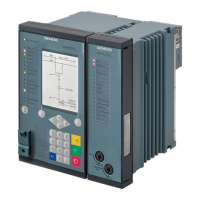[dwdocp34-240611-01.tif, 2, en_US]
Figure 7-99 Forward Characteristic of the Directional Function, Phase-Measuring Element
Direction Determination for Test Purposes
If you activate the binary input signal >Test of direction, the direction is determined and indicated even
without the current threshold being exceeded in one of the stages. The direction can be determined as soon
as current and voltage are greater than approx. 7 % of their secondary rated values.
Application and Setting Notes
Parameter: Rotation angle of ref. volt.
•
Default setting (_:2311:102) Rotation angle of ref. volt.= 45
o
The directional characteristic, that is, the position of the forward and reverse ranges, is set with the Rota-
tion angle of ref. volt. parameter. The short-circuit angle is typically to be found in a range from 30°
to 60° inductive. Therefore, in most cases, the default setting of +45
o
can be retained to position the reference
voltage, as it ensures a reliable directional result.
Some example settings for special applications appear in the following (Table 7-3). Please note that for phase-
to-ground faults (PG faults), the reference voltage (fault-free voltage) is vertical in relation to the short-circuit
voltage. This results in the following setting for the rotation angle:
Rotation angle of ref. volt. = 90 - φsh phase-measuring elements (PG faults)
Please also note that for phase-to-phase faults, the reference voltage is rotated between 0° (distant fault) and
30
o
(close-up fault) dependent upon the collapse of the faulted voltage (see Figure 7-98). You can take this
into account with an average value of 15°.
Rotation angle of ref. volt. = 90 - φsh - 15
o
phase-measuring elements (PP faults)
Table 7-3
Example settings
Application φsh
typical
Setting
Rotation angle of ref. volt.
60
o
Range 30
o
to 0
o
for PP faults
Selected: 15
o
7.6.7.2
Protection and Automation Functions
7.6 Directional Overcurrent Protection, Phases
696 SIPROTEC 5, High-Voltage Bay Controller, Manual
C53000-G5040-C015-9, Edition 11.2017

